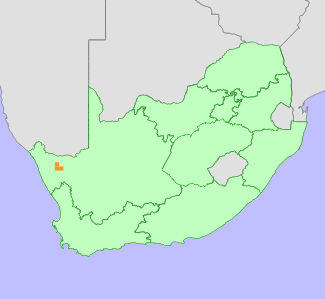|
Scientific Name | Conophytum lithopsoides L.Bolus subsp. lithopsoides |
Higher Classification | Dicotyledons |
Family | AIZOACEAE |
Synonyms | Conophytum kennedyi L.Bolus |
National Status |
Status and Criteria | Endangered A3d+4c |
Assessment Date | 2021/11/29 |
Assessor(s) | A.J. Young, P.G. Desmet, I. Ebrahim, D. Guo, A. Harrower, L. Jabar, L. Knoetze, C. Rodgerson, P.C.V. Van Wyk & N.N. Mhlongo |
Justification | This succulent is endemic to the Northern Cape province of South Africa with an extent of occurrence (EOO) of 404 km2 and area of occupancy (AOO) of 96 km2. The dwarf succulents that comprise this genus have been increasingly targeted by illegal collection in recent years and the vast majority of species are in high demand by collectors. Whilst there is no evidence of illegal collection at the time of this submission, closely related species, including some from the immediate area, have been illegally removed from habitat with a dramatic increase in the number of species and volume of plants targeted since 2019. The threat of illegal collection is therefore regarded as very high for this particular taxon, although its cryptic nature may limit collection. A decline of up to 75% of the population is likely within the next three generations (90 years) due to this activity.
Modelling of climate change impacts is predicted to result in an average loss of 99% of suitable bio-climatic habitat by 2080 under likely CO2 emission scenarios (RCP 2.6). Loss of vegetation cover has been observed indicating a decline in habitat quality. This taxon possesses certain traits that are expected to provide a level of resilience to climate change. Thus while model predictions place this succulent in the category Critically Endangered under criterion A3+4, the uncertainty of the response given the expected resilience of this taxon means the category is downgraded to Endangered. |
Distribution |
Endemism | South African endemic |
Provincial distribution | Northern Cape |
Range | This dwarf succulent is endemic to the winter rainfall area of the the Northern Cape province of South Africa. |
Habitat and Ecology |
Major system | Terrestrial |
Major habitats | Bushmanland Inselberg Shrubland, Namaqualand Klipkoppe Shrubland |
Description | This succulent is restricted to the Succulent Karoo biome where it is found in the Namaqualand Hardeveld and Richtersveld bioregions. The plants occupy quartz gravel flats that are often small in extent, but also small troughs or shaded crevices on quartz. This taxon has a generation length of 30 years. It is expected to be sensitive to the impacts of climate change as it does not disperse and while adapted to arid conditions, is dependent on limited seasonal rainfall. Species in the genus are sensitive to long periods of drought. Drought related mortality has been observed for other closely related taxa within the genus |
Threats |
| This particular succulent is not currently threatened by illegal collection but it is likely that it will become a target in coming years as there has been a dramatic increase in the number of species and volume of plants of this genus targeted since 2019. Related species within the immediate area have experienced severe declines in population number due to illegal collection. A decline of 50-75% in the population over three generations (90 years) is suspected due to illegal collection.
Anthropogenic climate change is a long-term threat to this taxon. Loss of vegetation cover has been observed across the geographic range occupied by this succulent via Landsat imagery between 1984 and 2018 indicating a decline in habitat quality. Climate models for the likely emission scenarios where emissions stay at present day levels (RCP 2.6) (Hausfather and Peters 2020) and worst case scenarios where emissions continue to increase during the 21st century (RCP 8.5) indicate that there will be a loss of suitable bioclimatic envelope of between 99% and 100% by 2080 for this taxon. However, as this taxon possesses certain traits likely to afford resilience to xerophytic conditions it is expected to have a level of resilience to climate change and the expected population loss is reduced by 20% to 79%. Species in this genus have limited dispersal ability and migration to suitable habitats elsewhere is regarded as highly unlikely. |
Population |
This succulent is more widespread than the other subspecies with numerous subpopulations identified. It is often locally abundant with an estimated 20,000 to 50,000 mature individuals present in habitat. The number of plants in this general area have been in decline in recent years due to an extended drought and the population may be in decline.
|
Population trend | Unknown |
Assessment History |
Taxon assessed |
Status and Criteria |
Citation/Red List version | | Conophytum lithopsoides L.Bolus subsp. lithopsoides | Rare | 2017.1 | | Conophytum lithopsoides L.Bolus subsp. lithopsoides | Least Concern | Raimondo et al. (2009) | | Conophytum lithopsoides L.Bolus subsp. lithopsoides | Lower Risk - Least Concern | Victor (2002) | | Conophytum lithopsoides L.Bolus subsp. lithopsoides | Insufficiently Known | Hilton-Taylor (1996) | |
Bibliography |
Hammer, S. 2002. Dumpling and his wife: New view of the genus Conophytum. EAE Creative Colour, Norwich.
Hammer, S.A. 1993. The genus Conophytum: A conograph. Succulent Plant Publications, Pretoria.
Hausfather, Z. and Peters, G.P. 2020. Emissions - the 'business as usual' story is misleading. Nature 577(618-620).
Opel, M.R. 2004. The rediscovery of Crassula alcicornis. Haseltonia 10:38-40.
|
Citation |
| Young, A.J., Desmet, P.G., Ebrahim, I., Guo, D., Harrower, A., Jabar, L., Knoetze, L., Rodgerson, C., Van Wyk, P.C.V. & Mhlongo, N.N. 2021. Conophytum lithopsoides L.Bolus subsp. lithopsoides. National Assessment: Red List of South African Plants version 2024.1. Accessed on 2025/11/07 |
 Comment on this assessment
Comment on this assessment


